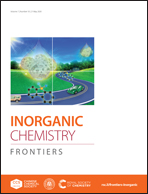Ag nanoparticle embedded Cu nanoporous hybrid arrays for the selective electrocatalytic reduction of CO2 towards ethylene†
Abstract
Electrocatalytic reduction of carbon dioxide (CO2RR) driven by renewable electricity is a promising strategy for chemical recycling of carbon. It can alleviate the carbon emission by reducing the carbon dioxide concentrations in the atmosphere, transforming low energy density renewable energy into high energy density carbonaceous fuels. Copper-based catalysts play an important role in the field of electrocatalytic CO2 because of their ability to reduce CO2 to hydrocarbons. However, problems such as high overpotential, catalyst deactivation, and uncontrollable product selectivity limit their further development. Herein, we construct Ag/Cu and Zn/Cu composite structures for CO2 reduction by employing tiny Ag nanoparticles and Zn nanocones uniformly distributed on the surface of porous network Cu nanowires. It is found that Ag/Cu composite structures are more active for the reduction of CO2 to C2H4, compared to those of Zn modified. The faradaic efficiency of CO2 reduction to ethylene reaches 41.3% and it remains stable for more than 8 hours. Theoretical calculations show that the modification of silver regulates the electronic structure of highly porous copper at the Cu/Ag interface, accelerates the process of carbon dioxide reduction of the first electron, enhances the adsorption of *CO and further facilitates *CO dimerization to ethylene. Therefore, the strategy of silver-modified porous copper pre-catalyst is a promising approach for CO2 reduction to hydrocarbons.



 Please wait while we load your content...
Please wait while we load your content...